We continue analyzing the Inquisition with points 3 and 4 of the previous article:Everything you believed about the Inquisition and it was not true.
He was sentenced in summary proceedings
Unlike the episcopal Inquisition, which depended on the good judgment of the bishops, and the medieval one, subject to the bulls and directives of the pope, the Spanish one, which, among other things, obeys its dual dependence on the pope and the kings, was delimited by civil legislation -also regulating the crime of heresy, equated to lese majesty-, by canonical regulations and by the Instructions (internal regulations issued by the Inquisitor General and the Council of the Supreme and General Inquisition). The Instructions do not classify crimes, but rather their role was to regulate the inquisitorial organization and other procedural aspects (organization, structure, inquisitorial procedures, the composition or scope of action of these courts -because let us not forget that the Inquisition was essentially an institution legal-). The first Instructions were drawn up in 1484 by Tomás de Torquemada and the last, because it had to be adapted to the passage of time and new realities, in 1561 by the Inquisitor General Fernando de Valdés. Therefore, the organization chart of the Inquisition would be as follows:Monarchy, Inquisitor General, the Council of the Supreme Court -presided over by the Inquisitor General- and the different territorial or provincial courts with two inquisitors and their corresponding «officials». So, with so much bureaucracy and legislation to follow, it is very difficult to think of lawsuits or summary procedures. In fact, it was not uncommon for these processes to drag on for months... or years.
Procedure and organization
After the Edict of Grace , where heretics or those who had the fly behind their ears to be accused could present themselves voluntarily, confess their sins and reconcile with the Church with a financial fine and some Our Fathers, the Edict of Faith , in which the people were informed of all the practices, behaviors or expressions considered heretical (new ones were being incorporated and the populace had to be informed). In this way, it was no longer possible to say that "I didn't know" and, in addition, the neighbor on duty -What nice neighbors!- had arguments to denounce the neighbor upstairs who played satanic music at full volume. As the Edict of Grace was not in great demand, it was suppressed and only the Edict of Faith was left, because the Inquisition could initiate a process by trade or by complaint. And although it is true that these complaints could be based on personal revenge and earthly issues unrelated to the faith (such as the volume of the music bothering you), you better have some heretical nuance (such as the music being satanic) and, logically, they were true, because, otherwise, you could be condemned for slander -And the inquisitors were not exactly idiots, they were prepared people-. And here the inquisitorial process began.

Whether ex officio or by complaint, with the evidence obtained or the accusations received, the qualifier of the provincial court had to determine "if there was a case" (if there was a crime against the faith). If so, the bailiffs proceeded to the arrest of the accused and the seizure of his assets (audited by the receiver or kidnapping notary ) to meet expenses during the time he was in the Inquisition prison . Logically, incommunicado detention, since secrecy is essential in this process, either so that the investigation is not hindered, or to guarantee the safety of the informers. The prosecutor He briefly reported his accusation -without specifying the specific crime or, logically, the complainants- and, in the event that he did not have Emilio Rodríguez Menéndez or Marcos García Montes on duty, he was assigned a ¡¡¡official lawyer !!!
When no person appears for the defense, the Inquisitors must provide a skilled and sufficient defender, and who is not of the Holy Office, who will be given the order that he must keep secret, communicating only with the accused [in the presence of a member of the Inquisition] and lawyers of the Office, and not with other people. (Instructions)
After a period of time in prison, which could last for months, in which the defendant thought a thousand times about what and who had brought him there, he was taken before the court itself, where the prosecutor accused and the two inquisitors (theological experts) did their job, inquiring, with the advice of the consultants (jurists). Not even at this point did the prisoner know exactly what he was being accused of, since the inquisitors' claim was spontaneous confession of their crimes, and they could be surprised -for them a prize- of having their tongues loosened and even blame himself for Manolete's death. So, in a good cop/bad cop tactic, the inquisitors deploy a whole arsenal of interrogation techniques. And the public defender, more typical of the American jurisdiction than the European one, defends him as best he can and tries to reach an agreement of the type:"if you plead guilty, they offer us...". All this process and the declarations are recorded meticulously and in detail by a secretary, the notary of secrets . Still, all is not lost. The accused has the possibility of submitting a list of witnesses for his defense and also, in the case of an open proceeding for a complaint, of enemies who could have filed the complaint against him for matters unrelated to faith - but without knowing who has filed it. presented, nor why. For the recusal of witnesses, the list of enemies is compared with that of denouncers, and it is investigated. In the event that the complaints are based on, for example, revenge or personal issues, their testimony is dismissed and, if necessary, can even end the process, the accused was released and recovered the seized assets (expenses discounted). In addition to swearing that he could not tell anything about what happened there, he had to report...
Whenever the Inquisitors take a prisoner out of jail, if he is not relaxed, by oath they will ask him about the things in jail, if he has seen communication between prisoners or other people outside the jail, and if he has notice of any prisoner. (Instructions).
The same procedure would apply if after the inquisitorial procedure it was found that the evidence was not sufficient or his explanations had satisfied the court. In the event that the evidence was sufficient to continue with the accusation, but there was no way for the accused to sing or to believe that he was lying, one could resort, as an extreme case, to the search for the truth through torment - torture of all life that we will see in the next point-.
After this long and meticulous procedure and when there is absolute certainty of guilt, due to the evidence or the confession of the accused, the process concludes with the meeting of the inquisitors to deliberate. At this point, it was very difficult, if not impossible, for the sentence not to be guilty and, as a result, to participate in the corresponding Auto de Fe . Of course, it had to be unanimously and, otherwise, it would be the Supreme Council that decided. The penalties, depending on the crime, were spiritual (Our Fathers, retiring to meditate, public humiliation...), economic (fines or confiscation of property) or physical (scourges, prison, galleys or death). So far the inquisitorial process, which could last months or years. And when we think that everything is lost, we can still give ourselves an opportunity - an opportunity that we have throughout the whole process. We are left with repentance, abjuration and reconciliation with the Church:abjuration of levi, for those accused of heretical practices, let's say minors, such as blasphemers, bigamists, convicted of simple fornication... (because this heretical practice was very relative) or abjuration of vehementi , for major heretical practices (Judaizers, Protestants...).
Since I know you don't know what this crime of «simple fornication is about, «, I explain it to you. You are with the bride and you think the time has come, but she tells you no because not being married is a sin and she must be a virgin at marriage. You, full of reasons, tell her that she is wrong, that this cannot be a sin, because you are going to make her see heaven. In the end, your girlfriend gives in and… you screwed up. Her remorse won't let her sleep, and the next morning, your girlfriend tells her mother that you've tricked her into convincing her that premarital sex isn't a sin. And her mother, who doesn't like you at all, denounces you to the Inquisition... and they arrest you. Not for lustful or fornicating without being married, but for arguing that fornication outside of marriage is not a sin. She already drinks… The best thing is to abjure and the thing will remain in a financial fine, which will force you to work extra hours at Telepizza, and in public humiliation. Of course, with that mother-in-law I don't think your relationship will go very far.
Thus, the abjuration entails the reduction of the penalty (remaining in spiritual and some economic for the majority of heretical practices), and even saving from relaxation , the delivery to the secular arm so that it dictates death sentence and executes - as we have already said, the Inquisition could not kill - for the most serious cases, such as Judaizers. Only, and I say only because of the inflated figures attributed to the Spanish Inquisition, those who after the entire process were convicted of more serious accusations of heresy and did not abjure and reconcile with the Church (unrepentant> ), as well as repeat offenders (relapses ), previously condemned as heretics and who had avoided relaxation by repenting and abjuring -if you've already escaped once, don't keep dizzying the partridge-, were executed and all their property was confiscated. The relaxed directly at the stake and the relapses, thanks to the second repentance, strangled before being burned.
A case apart, in this complex inquisitorial civil service, the relatives deserve , the ears and eyes of the Inquisition. Despite their name, they were not related by blood to the members of the Inquisition, but were instead a group of lay Christians who assisted the courts in minor matters and provided information. Not everyone was good for these tasks; they had to be "clean of blood" and, in return, were exempt from certain taxes and enjoyed certain social benefits. So, being a privileged position, their number in the towns had to be limited by the number of inhabitants.
And, finally, the end of the party:the General Auto de Fe , «the public and solemn reading of the summaries of the processes of the Holy Office, and of the sentences that the inquisitors pronounce with the presence of the prisoners or effigies (in the absence of a prisoner) that represent them, concurring all the authorities and respectable corporations of the people, particularly the ordinary royal judge, to whom persons and statues sentenced to relaxation are handed over there, so that he may then pronounce sentences of death and fire, according to the laws of the kingdom, against heretics, and immediately have them executed, having for this purpose prepared the burner, the firewood, the necessary garrote and executioners, for which purpose timely notices are anticipated by the inquisitors ”. Although this was the spectacular one, surrounded by pageantry and paraphernalia, there were also less formal ones and even carried out in the privacy of the Holy Office facilities. The Auto de Fe began with a procession, where the active forces, the religious orders, all the notables of the city disputed the honor of escorting the flag of the Holy Office, and where the citizens attended as spectators. Behind them, the accused with the different «sanbenitos » (poncho-type garment) and «corozas » (capirote-type cap) that indicated their condemnation:abjured from levi, from vehementi, the relapses and the unrepentant. The members of the tribunal of the Inquisition brought up the rear. Finally, the corresponding mass and everyone goes home to think about what they have seen, how good Christians they are going to be and how well they are going to get along with their neighbors. Of course, even if you escaped death, the fact of wearing the sanbenito marked you...
If they don't burn you, they scorch you...
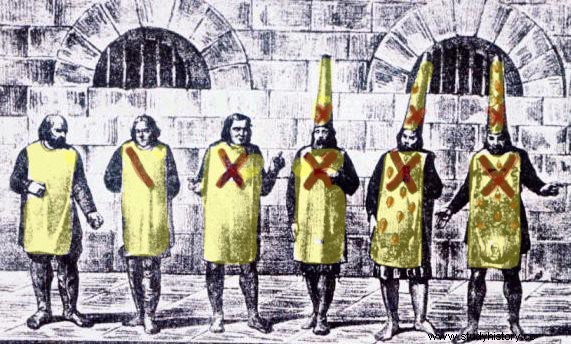
Sanbenitos
Making it clear that a single execution for thinking differently or professing another religion is already a lot, a small note on the figures. The latest data speak of some 150,000 inquisitorial processes (25% for blasphemy) and around 5,000 fatalities, of which almost 2/3 were due to Judaizers. For example, in the context of the religious wars, it is estimated that more than 2,000 Huguenots (French Protestants) died in Paris in just one night (the massacre of Saint Bartholomew, on August 23, 1572) and, in the following months, over 10,000 throughout France.
The prisoners were subjected to multiple and varied tortures, especially bloody
Was there torture in the inquisitorial processes? Yes, but nothing to do with how we have been told. First, torture has been used as a method to extract a confession from a suspect since time immemorial until, theoretically, the 18th century, in practice... -let each one put a date on it-; and, second, in the Inquisition it was perfectly regulated and delimited.
On many occasions, it was enough to take the prisoner to the torture room, show him the instruments and explain how it works, so that his tongue would loosen and he would confess even the armholes when buying bread when he was little. Otherwise, the court gave the order to the professional of these tasks (professional of civil justice contracted for work and service by the Holy Office) and, always, in the presence of the doctor of the Inquisition, whose role was to "control" the torment so that the accused would not remain on the "operations" table and, very importantly, so that there would be no blood -it was forbidden-, with the power to stop the torment if he considered it opportune. So, all those especially bloody and bloody torture devices and gadgets that are attributed to the Inquisition, nothing at all. The only three tortures admitted by the Inquisition, which I am not saying were few, since torture is unjustifiable in our world and with our mentality, were:the garrucha (causes dislocation of the upper extremities), the water (also called play , which causes the sensation of suffocation) and the foal (disjoin bones) -none of them original from the Holy Office (already used in civil justice) and none of them is bloody-. When the prisoner sings, he is returned to his cell and, after some time for him to recover, he must ratify his confession outside the torment room for it to be valid. If they don't or if he retracts, they could torture him again.
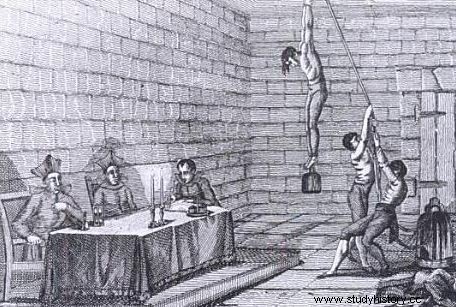
Garrucha
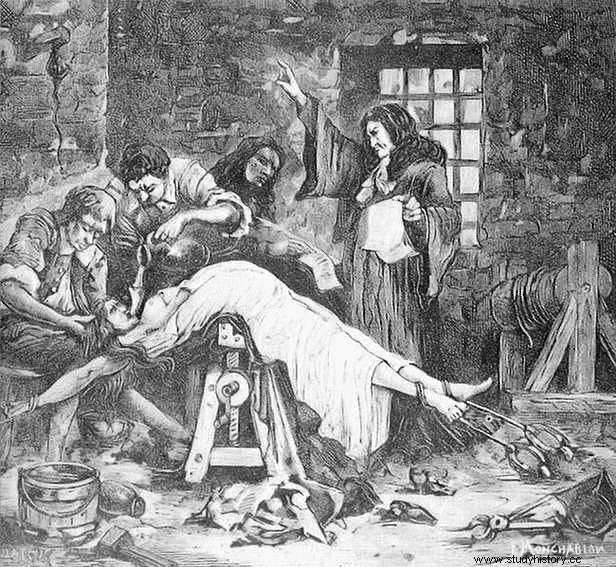
Water torture (touch)
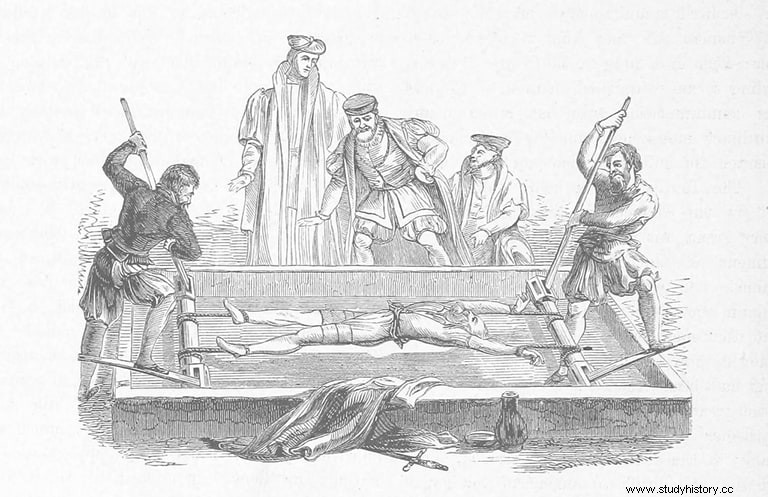
Colt
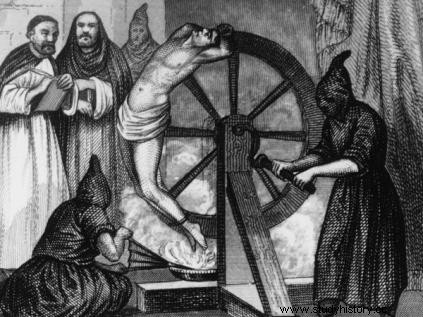
Colt
As I explained before, the job of the secretary was to record everything, even the «Ay, ay, ay! For for! I killed Kennedy «. Well, as long as they weren't thick words that were replaced by the recurring "..." -if they had recorders it would have sounded like a piiiiiiiiiiiii-.
And I will finish this point with the prisons of the Inquisition, which were divided into two:in which the accused were held awaiting sentence, such as those of civil justice, and the houses of penitence where prison sentences were served. Of the former, it can only be said that they were typical of their time and of the latter… less terrible than the image that has been sold. In fact, there are known cases in which, before civil justice, a blasphemy was confessed so that the case would go to the Inquisition and serve the sentence in its prisons. Even, depending on the heretical crime, the "open regime" was allowed, in which they only came to spend the night. And, as has always existed, since the first caveman locked someone else in a cave with bars, if you were from a family of possibles, everything was more benevolent -with a small donation to the jailers' union, you were allowed to bring food from home and you could furnish the cell to your liking. Also the opposite case, convicts solemnly poor, who were released or sent to the galleys to save maintenance. Of course, despite all this they still did not have television, air conditioning, a gym, reading rooms, workshops and three meals a day. Nor healthy menus, but surely, to annoy false converts -Judaizers or Moors-, there was pork every Sunday.
So, we can conclude that the Inquisition tortured less than the civil courts and, always, after exhausting other means of obtaining a confession. In 1533 the Supreme ordered that torture be applied only in extreme cases and never when the crime judged deserved a lower penalty than torture itself.
Third part
